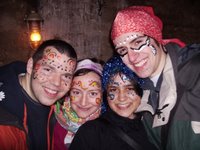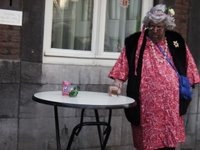Class, volunteer stuffs, internships, carnivaal, biking in the snow :*) I heart Amsterdam


Last night we stepped out of class to the welcoming flurried, sticky snow saturated wonderland of Amsterdam coated in fabulous white stuff :*). In the period of half an hour, I somehow engaged in three snowball fights and one bike wipe out on Prins Hendrikade underneath a bridge, haha. Only one of the
 snowball fights was intentional, one was a hit and run by a little Morrocan boy who promptly retreated into a fallafel stand before we could process what hit us, and the other was an ambush by some roving Dutch teens we had never seen. It all took place in the street right outside my apartment building and quickly escalated into an all out war, involving plenty of yelping, skewed aim and the inlisting of a few comrads to settle the score. Snow... who knew it could bridge so many a cultural barrier :*)
snowball fights was intentional, one was a hit and run by a little Morrocan boy who promptly retreated into a fallafel stand before we could process what hit us, and the other was an ambush by some roving Dutch teens we had never seen. It all took place in the street right outside my apartment building and quickly escalated into an all out war, involving plenty of yelping, skewed aim and the inlisting of a few comrads to settle the score. Snow... who knew it could bridge so many a cultural barrier :*) but really interesting too. I'm also taking another Dutch class (een kopje thee voor u??) and a course called "Communication in Conflict Situations" which is a interesting combination of philosphy and theater. For fun I am applying my handstand shenanigans and my secret desire to break dance in a Capoiera class, which is so invigorating and such hard work....It is this Afro-Brazilian form of self-defense/acrobatic/rythmic dance/Portugese singing/drum pounding ensemble. After my first class I was finally able to bend over without sincere identification with 85 year old body pains 4 days later, haha.
but really interesting too. I'm also taking another Dutch class (een kopje thee voor u??) and a course called "Communication in Conflict Situations" which is a interesting combination of philosphy and theater. For fun I am applying my handstand shenanigans and my secret desire to break dance in a Capoiera class, which is so invigorating and such hard work....It is this Afro-Brazilian form of self-defense/acrobatic/rythmic dance/Portugese singing/drum pounding ensemble. After my first class I was finally able to bend over without sincere identification with 85 year old body pains 4 days later, haha.I also got this internship/volunteer research job with the Salvation Army to do research on sex trafficking focused on Western and Eastern European policies, laws, organizations. In April I will get to go around with one of the women who does street work visiting brothels and talking with actual prostitutes, bringing them tea, saying hello, making a humane connection with the women as a kind of affirmation of the organization's interest in them as people and to be available for them if they need anything. I also may get to help with a special retreat they put on for homeless women and prostitutes in April as well.

I might get a chance to volunteer some with the Legal Advocacy Department of this anti-sex trafficking group called Bonded Labour In The Netherlands (http://www.blinn.nl/?c=home&lang=gb) to help victims get to their embassies and sift through legal issues.... that is still pending, but looks like it will work out.
Last weekend me and some friends hopped a train to Maastricht in the very southern tip of The Netherlands to Carnivaal- a crazy creative Mardi-Gras celebration invovling plenty of sparkles, face paint, plummage, flambouyant costumes, and so many families!! oh it was soo much fun... These are a few select pictures from it - M.J. the guy in the sparkly blue wig, Neah the woman in the sparkly blue wig :*) Andrew in the red bandana were just a few of my accomplices.

So anyways, life it going well here, the crowd this semester isn't such an outrageousparty-go-crazy-stay-in-your-american-ghetto
-and-smoke-pot-all-day group, which is refreshing after a little too much of that last semester...hmm. I feel like I am begining to build some meaningful friendships here as well, settling in as I always will be, but more sure of what I need, or at least more aware of the questions to be lived.







